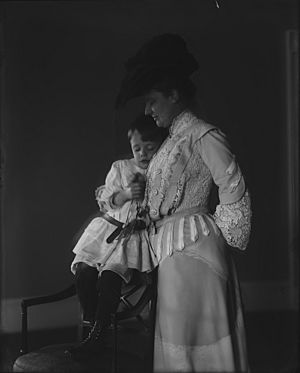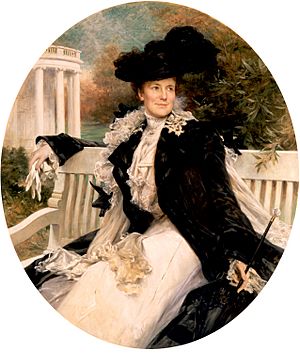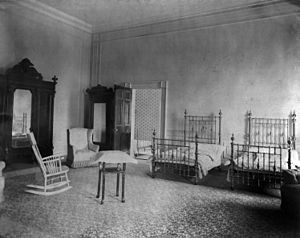Edith Roosevelt facts for kids
Quick facts for kids
Edith Roosevelt
|
|
|---|---|
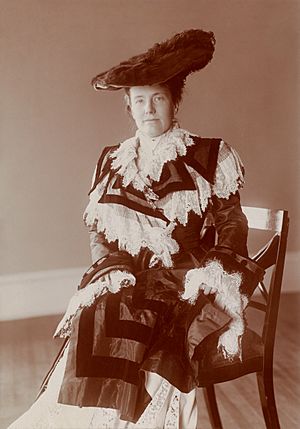
Portrait by Frances Benjamin Johnston, c. 1903
|
|
| First Lady of the United States | |
| In role September 14, 1901 – March 4, 1909 |
|
| President | Theodore Roosevelt |
| Preceded by | Ida McKinley |
| Succeeded by | Helen Taft |
| Second Lady of the United States | |
| In role March 4, 1901 – September 14, 1901 |
|
| Vice President | Theodore Roosevelt |
| Preceded by | Jennie Hobart |
| Succeeded by | Cornelia Fairbanks |
| First Lady of New York | |
| In role January 1, 1899 – December 31, 1900 |
|
| Governor | Theodore Roosevelt |
| Preceded by | Lois Black |
| Succeeded by | Linda Odell |
| Personal details | |
| Born |
Edith Kermit Carow
August 6, 1861 Norwich, Connecticut, U.S. |
| Died | September 30, 1948 (aged 87) Oyster Bay, New York, U.S. |
| Resting place | Youngs Memorial Cemetery |
| Spouse | |
| Children |
|
| Parent |
|
| Signature | |
Edith Kermit Roosevelt (born Carow; August 6, 1861 – September 30, 1948) was an important figure in American history. She was the second wife of President Theodore Roosevelt. She served as the First Lady of the United States from 1901 to 1909. Before that, she was the Second Lady of the United States in 1901. Edith Roosevelt was the first First Lady to hire a full-time assistant to help with social events. Her time in the White House helped make the role of First Lady more official and important.
Contents
Early Life and Family
Edith was born on August 6, 1861, in Norwich, Connecticut. Her father, Charles Carow, was a merchant. Her mother was Gertrude Elizabeth Tyler. Edith's grandfather, Daniel Tyler, was a general in the American Civil War.
Edith had a younger sister named Emily. She also had an older brother named Kermit, who sadly died before she was born. Edith was often called "Edie" by her family and friends.
She grew up in New York City on Union Square. Right next door lived Theodore Roosevelt, who would later become her husband. Edith and Theodore's younger sister, Corinne, were best friends.
Edith, Corinne, Theodore, and his brother Elliott all went to school together at the Roosevelt family home. Edith later attended Miss Comstock's finishing school.
Theodore and Edith knew each other from childhood. They may have had a romance when they were teenagers. However, their relationship changed when Theodore went to Harvard University. He later married Alice Lee, and Edith even attended their wedding.
Marriage to Theodore Roosevelt
Theodore Roosevelt's first wife, Alice Lee Roosevelt, passed away in 1884. She left behind their baby daughter, also named Alice. Theodore and Edith became close again in 1885.
They married in London, England, on December 2, 1886. Theodore was 28, and Edith was 25. Their engagement was announced in the New York Times. After their honeymoon, they lived at Sagamore Hill on Long Island, New York. Theodore called his first daughter "Baby Lee" to avoid reminding himself of his first wife's death.
Together, they raised Alice (Theodore's daughter from his first marriage) and their five children:
- Theodore III (born 1887)
- Kermit (born 1889)
- Ethel (born 1891)
- Archibald (born 1894)
- Quentin (born 1897)
In 1888, Theodore was appointed to the United States Civil Service Commission. Edith supported his work, even though it meant moving to Washington, D.C. She and the children joined him there. During this time, Edith became good friends with writer Henry Adams.
Edith preferred their life in Washington, D.C. She convinced Theodore not to run for mayor of New York in 1894. When Theodore became New York City police commissioner in 1895, the family moved back to New York. In 1897, they returned to Washington when Theodore became Assistant Secretary of the Navy.
In 1898, Edith traveled to Tampa, Florida, to see her husband off to fight in the Spanish–American War. When he returned from Cuba, Edith went to meet him in Montauk, New York. She even helped veterans at the hospital there.
First Lady of New York
Edith Roosevelt enjoyed her role as First Lady of New York. She updated the governor's mansion and joined a local women's club. She also continued to help her husband with his letters.
While First Lady of New York, Edith started a tradition. She would hold a bouquet of flowers in each hand when greeting people. This was because she preferred to bow her head instead of shaking hands with strangers.
When Theodore won the vice presidency in 1900, Edith moved back to Washington, D.C.
First Lady of the United States
After President William McKinley’s death in 1901, Theodore Roosevelt became president. This meant Edith became the nation’s First Lady.
Since the country was in mourning, Edith could not host many parties at first. Instead, she focused on making the White House a comfortable home for her large family. She even took on some of the housekeeper's duties herself.
Edith Roosevelt made an important change by hiring Belle Hagner as the first social secretary for a First Lady. Hagner helped plan events and released photos of the First Family. This helped control how the family was seen by the public.
Edith expanded the number of social events at the White House. She made sure that the First Lady's parties were the most important in Washington. She worked to make Washington a cultural center for the nation. Two big events during her time were her stepdaughter Alice's wedding and her daughter Ethel's coming-out party.
Edith also brought together the wives of the cabinet officers. She tried to guide social behavior in Washington through who was invited to White House events.
Many believed Edith had a quiet but strong influence on her husband. They met privately every day to talk. She read several newspapers daily and shared important articles with him. Historians believe she helped her husband get unofficial information about the Russo-Japanese War from a British diplomat. This link helped President Roosevelt win the Nobel Peace Prize in 1906 for helping to end that conflict.
The President and First Lady made history by being the first to travel abroad while in office. They took a trip to Panama.
An aide once described Edith Roosevelt as a "gentle, high-bred hostess." She often smiled and was understanding of others.
In 1905, Edith bought Pine Knot, a cabin in rural Virginia. It was a quiet place for her husband to relax.
White House Renovation
In 1902, Edith hired architects to renovate the White House. The goal was to separate the living areas from the offices. They also made the public rooms larger and more modern. Congress approved over half a million dollars for this work.
The new West Wing was built for offices. The East Wing housed the president's family and guests. The plumbing, lighting, and heating were all improved. Edith even placed her office next to her husband's so they could talk often.
Edith wanted to honor the White House's history. She made sure the Green Room, Blue Room, and East Room were redecorated with antique furniture from earlier periods. She saved many Victorian pieces that are still in the White House today.
A larger dining room meant they needed more dishes. Edith ordered a new Wedgwood china set with the Great Seal of the United States. This made her curious about the china sets of past First Ladies. She completed a catalog of White House china that Caroline Harrison had started. She also bought missing pieces from antique shops. When she left the White House, there were pieces from twenty-five different presidencies. She created a display of the china on the ground floor of the White House, which is still there today.
Across from the china display, Edith showed portraits of former First Ladies. This display was very popular with the public and guests.
Edith also asked the White House gardener to help her design a colonial garden on the west side of the White House. A similar garden was later added to the east side.
The public first saw the renovated White House during the New Year's Day reception in 1903. It was during Edith's time as First Lady that the building officially became known as the White House. Before that, it was called the Executive Mansion.
Relationship with Her Children
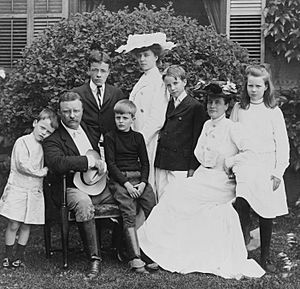
Edith Roosevelt was a very loving mother. She spent several hours each day with her children and read to them daily. Both she and her husband were actively involved in their children's education. They often wrote to their children's teachers.
Edith had a complex relationship with her stepdaughter, Alice. However, in later years, Alice admired Edith's sense of humor. Alice wrote in her autobiography that Edith handled their family situation with "fairness and charm and intelligence."
The Booker T. Washington Dinner
On October 16, 1901, President Roosevelt invited Booker T. Washington, a famous African-American educator, to dine with his family at the White House. While other presidents had met with African-Americans at the White House, this was the first time one was invited to a meal.
News of the dinner became a national sensation. It sparked many discussions about race in the country. Some people tried to say it was just a lunch, not a formal dinner. However, years later, Edith Roosevelt confirmed it was indeed dinner.
This dinner helped establish Booker T. Washington as a leading voice for African Americans in the United States.
Later Life and Death
After leaving the White House, Edith traveled widely. She visited Europe, Asia, Africa, and South America. While Theodore and Kermit went on a safari, Edith took Ethel, Archie, and Quentin on a long tour of Europe.
The Smithsonian’s First Lady collection was started soon after the Roosevelts left the White House. Edith helped by donating part of her inaugural gown.
Edith supported her husband when he ran for president again in 1912. She cared for him after an assassination attempt and comforted him when he lost the election. She also joined him on a trip to Brazil. Both Edith and Theodore helped with efforts at home during World War I. For example, Edith was the honorary president of The Needlework Guild of America, which provided new clothes to the poor.
After the 19th Amendment was passed, giving women the right to vote, Edith encouraged Republican women to vote.
On January 6, 1919, her husband, Theodore Roosevelt, passed away at the age of 60.
During the Great Depression, Edith briefly campaigned for Herbert Hoover. She wanted to make it clear that the Democratic candidate, Franklin D. Roosevelt, was not her son.
Before she died, Edith destroyed most of her letters with her husband. However, many of her other letters still exist in archives today.
Edith died at Sagamore Hill on September 30, 1948, when she was 87 years old. She is buried next to her husband at Youngs Memorial Cemetery in Oyster Bay.
Images for kids
See also
 In Spanish: Edith Kermit Carow Roosevelt para niños
In Spanish: Edith Kermit Carow Roosevelt para niños


